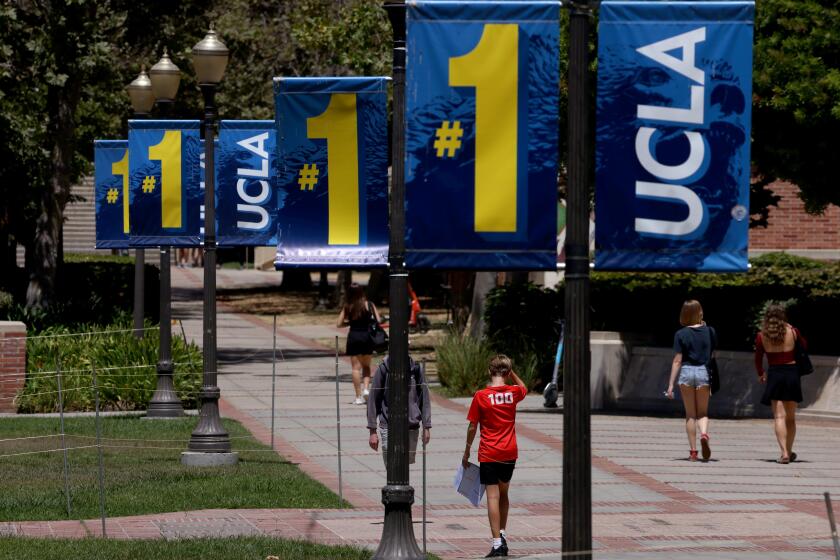Three Soviet Warships Sail Into San Diego
- Share via
SAN DIEGO — Three Soviet warships sailed into the once-forbidden waters of San Diego Harbor and into history Tuesday, marking the first such military visit to the West Coast in more than a century.
Against the backdrop of the Coronado Bridge and docked U.S. Navy vessels, the two Soviet destroyers and an oiler pulled into Pier 2 at the 32nd Street Naval Station after they exchanged 17- and 21-gun salutes with their U.S. counterparts.
The Soviets were escorted by flocks of smaller pleasure boats, Coast Guard vessels and rubber rafts holding Greenpeace environmentalists, who unfurled banners in Russian urging nuclear disarmament. Soviet sailors, however, cheered the banners and the opening ceremonies proceeded with no interruptions.
“The world is changing fast,” Adm. Genadiy Alexandrovich Khatov, commander of the Soviet Pacific Fleet, declared through an interpreter. “If you asked me a year ago if I thought it was possible to come to the United States, the answer would have been negative.”
The last time Russian naval vessels docked on the West Coast was in 1863.
While top-ranking naval officers for each country expressed lofty goals for the unprecedented visit, many of the 850 Soviet sailors had other plans.
“Before, we were told that capitalism was bad; now, capitalism is good,” said Oleg Ozlov, a 20-year-old petty officer who lives outside Vladivostok. “I just want to walk around and talk to people.”
Others had more specific plans. Speaking in broken English, 30-year-old Senior Lt. Dmitri Abramov, a navigator, said he wished to go see “fish house.” Seeing the puzzled faces around him, Abramov requested an interpreter, who explained that the young man wanted to visit Sea World, which is included in the busy schedule in the days ahead.
The arrival of the three Soviet ships--the Admiral Vinogradov, the Boyevoy and the Argun--for the five-day visit represents the second round of an exchange program established by Adm. William Crowe, former chairman of the U.S. Joint Chiefs of Staff, and Marshal Sergei Akhromeyev, former Soviet chief of staff.
The first round began last July, when ships from the Soviet navy visited a U.S. naval base in Norfolk, Va. The next month, ships of the U.S. Navy sailed to Sevastopol in the Crimea. This September, the reciprocity will continue as three U.S. ships travel to Vladivostok, where the Soviet Pacific Fleet is headquartered.
Adm. Charles Larson, commander of the U.S. Pacific Fleet, said the visit was designed to foster goodwill.
“We want to exchange ideas and opinions so we can better understand each other,” Larson said.
After the Soviets’ 9 a.m. arrival, the Soviet vessels hoisted their signal flags amid plumes of gray smoke. Lines of white-clad sailors formed at the rails, like stripes on the huge ships, as they took in their first glimpse of Southern California. Bright yellow cranes lumbered on the pier as the ships secured their moorings and a Soviet military band played.
Larson and San Diego Mayor Maureen O’Connor welcomed the guests with a version of the traditional Russian khelbsolstvo, the bread-and-salt hospitality ceremony. The American hosts offered pieces of dark rye bread dipped into a shallow dish of salt, as a symbol of sustaining life and offering good taste.
Minutes before Khatov, Larson and O’Connor spoke to a small crowd of mostly U.S. Navy officials, the Navy’s elite daredevils, the Blue Angels, flew in diamond formation overhead. After the speeches, the sailors from the Soviet ships were allowed to mingle with those from their American hosts’ ships, the guided-missile cruiser Leahy, the frigate McClusky and the Merrill, a destroyer.
The scene quickly deteriorated into a frenzy of hugs, photo-takings and gift exchanges between U.S. and Soviet sailors. Though many U.S. sailors asked their counterparts for their large white, pie-shaped hats adorned with long ribbons, the request was usually turned down. One officer explained that no sailor would be allowed off the ships out of uniform and most had only one hat.
For several hours, sailors and a select group of San Diegans were allowed to board two of the Soviet vessels, and there, aboard the ships, the gift-giving continued.
“They are not supposed to be our allies; they are supposed to be our enemies,” said Steve Prairie, a 27-year-old Albuquerque native who joined the Navy two years ago. “And here they are, we are trading information, hats, pins, belts, everything.”
Some had other interests in the visit.
Petty Officer 2nd Class Dave Tepper, 26, brought a video camera aboard one of the Soviet vessels and said he surreptitiously filmed the bridge navigational and radar systems. Tepper, a sonarman, had trained for years to detect vessels just like the one he had boarded.
“It’s neat to see what we were looking for all these years,” said Tepper, a Chicago resident.
More to Read
Sign up for Essential California
The most important California stories and recommendations in your inbox every morning.
You may occasionally receive promotional content from the Los Angeles Times.













